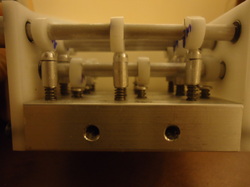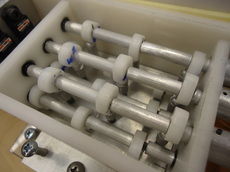Mechanical System Overview

To actuate the strings, we coupled servos to camshafts. The camshafts, when rotated to a specific position, would press down pins above certain strings. With the strings depressed, we would actuate our strumming mechanism, a servo mounted above the sound hole which brushed a guitar pick across the strings. The combination of these tasks performs the same task as an actual guitarist!
Challenges
The troubles regarding mechanically actuating a guitar revolve around packing 6 actuation mechanisms per fret into the space above one fret. Because each cam needed a change in radius large enough to depress the guitar string, the cams could only be made so small. Thus, to fit all the cams in, we placed the camshafts in two tiers, effectively doubling the space we had to work with.
Solution: Holding Tight Tolerances

Because we had so little space to work with, it was necessary to construct our mechanism to tight tolerances and eliminate as much flex as possible. To that end, our camshafts were made of square key stock, , which is much stronger than a round piece of the same thickness. The camshafts were supported by bearings, allowing for smooth and consistent rotation. The custom designed cams were laser cut, then sanded, and the pins moved inside precision-reamed holes. The combination of these factors reduce the forces necessary to actuate all six strings at once, reducing flex in the mechanism and creating a more accurate system.
Future Plans
In the future, we would like to modify the design of the cams to allow for a greater pin actuation distance. This would decrease pin interference with the vibrating strings, resulting in a cleaner sound. We would also like to put a rubber tip on the end of each pin, to eliminate any unintentional micro-tones resulting from partially pressed strings. Eventually we would like to scale our current design to be able to actuate the first five frets of the guitar, which will allow us to play any major and minor chord.
